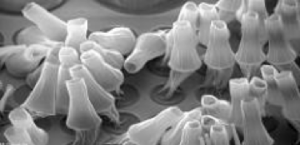Carbon nanotube lanterns are an example of nanotechnology, a rapidly expanding field with many possibilities | Credit: Michael De Volder (in Engineering at Cambridge) (through Flickr)
By Hoang-Nam Vu, Staff Writer & Researcher for Save The Water™ | August 25, 2018
A World of Bigs and Smalls
As technology progresses, our technologies seem to become much larger or smaller. The Large Hadron Collider, constructed by the European Organization for Nuclear Research (CERN) is an example of a facility that is massive and complex. On the other side of the spectrum, however, is the miniscule world of nanotechnology. This is a world that is growing to dominate the modern tech industry. It may, however, have unforeseen consequences.
What is Nanotechnology?
A nanometer is defined as one millionth of a millimeter, about 100,000 times smaller than the diameter of a human hair.1 Nanomaterials have at least one dimension that is less than 100 nanometers.1 Because of their minute size, the prevalence of nanomaterials in our day-to-day lives may be hard to grasp. However, nanomaterials can be found in nearly every facet of the manufacturing industry. Since nanomaterials can be engineered to take on unique properties, their size makes them ideal for use in electronics, medicine, commercial manufacturing, food production, and numerous other fields. The National Institute of Health says that “thousands of common products—including sunscreens, cosmetics, sporting goods, stain-resistant clothing, tires, and electronics—are already manufactured using engineered nanomaterials [ENMs],” while ENMs can be also be used “in medical diagnosis, imaging, and drug delivery and in environmental remediation.”1
Nanomaterials and the Environment
As the nanomaterial industry grows, so does its relationship with the environment. For one, nanomaterials are being used in environmental remediation technology. In recent years, nanomaterials have been used in water filtration and refinement. They are effective because of their adsorptive properties and their photocatalytic and antibacterial activity.2 One example of these properties at play is described in a 2017 report from the University of Washington. Researchers there used conductive nanomaterials in a sort of “paper” to detect water levels.3 “When water hits the paper,” the report notes, “its [the complex of wood fibres and nanomaterials] fibrous cells swell to up to three times their original size. That expansion displaces conductive nanomaterials inside the paper, which in turn disrupts the electrical connections and causes the LED alarm indicator light to turn off.”3 The paper notes that such a water sensor can be helpful in the biofuel and petroleum industry, where water is undesirable. It can also be used to detect structural flaws in water piping. The sensor can easily check if a pipe is leaking and help to avoid water contamination from metal leakage. Also, the nanomaterials “added to the paper were engineered in such a way that they can be incorporated during conventional paper making without having to modify the process.”3 The relative ease at which nanomaterials can be included in modern processes makes them good candidates for growing technology in the field of environmental science. It’s clear that nanomaterials have much to contribute to the future of remediation technology.
Possible Negative Consequences
On the other hand, nanomaterials could have negative impacts on the environment. One major role of nanomaterials is in the agricultural industry. Here, miniscule particles of metals and carbon nanotubes are used in certain pesticides and fertilizers. They are used in this way mainly because of their efficacy at lower doses when compared to conventional products.4 However, this means that these nanoparticles, if not dissolved or filtered beforehand, can enter nutrient runoff that flows down agricultural areas and into local waterways. Runoff from farms treated with traditional NPK fertilizers, whose main active ingredients include nitrogen, phosphorus, and potassium, can disrupt the natural chemical composition of water sources and have ecological consequences. Most often, the increased concentrations of nitrogen, phosphorus, and potassium, in particular, lead to a rapid increase of algal species, termed an “algal bloom.” The increased stress the algae puts on the oxygen content of the water often leads to widespread plant and animal death, a process called eutrophication (explained further at https://stg.savethewater.org/2016/09/06/floridas-algal-blooms/). Nanomaterials, when combined with nutrient runoff, can make problems of eutrophication worse, as a Duke University study found that “big algal blooms were more than three times more frequent and more persistent in tanks where nanoparticles and nutrients were added together than where nutrients were added alone.”4 The dangers of more intense algal blooms could lead nanomaterials used in the agricultural sector to cause more harm than good. This, in turn, could raise doubts about nanomaterials used in other fields. For example, nanomaterials could be leaked into surface water sources during the disposal of nanoparticle-centric products. Lab experiments have shown exposure to nanoparticles “can lead to cell death, DNA damage, and increased reactive oxygen species.”5
What’s Next
All in all, the use of nanomaterials in technology can have beneficial and detrimental effects. It is clear that nanomaterials could have numerous upsides for many fields. However, their responsible use is vital to their success and the avoidance of potential harm. The next steps for nanomaterials are yet to be seen, but one thing can be sure—their use must be well thought out before any more steps are made.
References:
- National Institute of Environmental Health Sciences. May 24, 2018. “Nanomaterials.” National Institute of Environmental Health Sciences. https://www.niehs.nih.gov/health/topics/agents/sya-nano/index.cfm
- Chella Santhosh, et. al. December 15, 2016. “Role of nanomaterials in water treatment applications: A review.” Chemical Engineering Journal 306, 1116-1137. https://www.sciencedirect.com/science/article/pii/S1385894716311287
- The Engineer. November 13, 2017. “Nanomaterials added to paper to make sustainable water sensor.” Centaur Communications Ltd. https://www.theengineer.co.uk/nanomaterials-paper-sensor-water/
- Duke University. June 25, 2018. “Nanomaterials could mean more algae outbreaks for wetlands, waterways.” ScienceDaily. https://www.sciencedaily.com/releases/2018/06/180625192724.htm
- Kellogg J. Schwab. March 7, 2012. “Are nanoparticles a threat to our drinking water?” The Johns Hopkins Water Institute. http://water.jhu.edu/index.php/magazine/are-nanoparticles-a-threat-to-our-drinking-water


